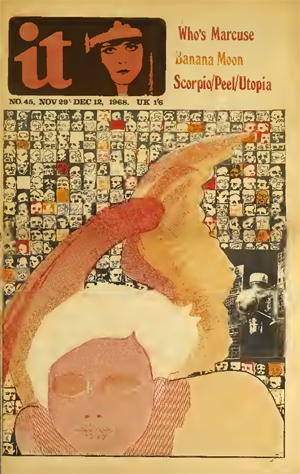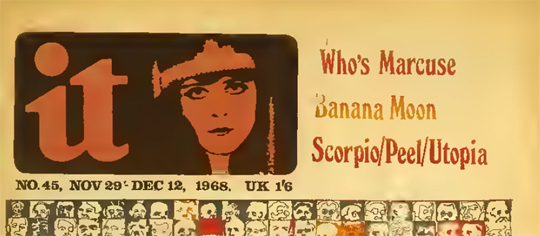| |
|
|
 Soft Machine - International times N°45 - 29 November 1968 Soft Machine - International times N°45 - 29 November 1968
SOFT MACHINE
SEVERAL exotic people were sitting on the floor at an Indica Gallery opening in 1966, the tall one with the Dr Strange cape was called Michael, he said: "We've asked William Burroughs if it was OK and he said 'I suppose it'll be alright' so we're going to call ourselves THE SOFT MACHINE."
From under the influences of Cornelius Cardew, John Cage, Tilbury and the New York Fluxus Group they assembled, learnt to play instruments in order to play the strange sounds in their heads, and played! They played at IT's celebration party at the Roundhouse for our first issue, where they had Norman with them who played Motor-cycle and took people for rides on it round the edges of the building when it wasn't needed as an instrument
They also had Daevid Allen, writing songs, singing and using his poetry and electronic knowledge picked up when his houseboat was moored on the Seine on the Left Bank and he was involved with the French "machine poets".
 |
The Soft Machine, famous for running over Jerry Fitzgerald's giant jelly in the IT Uncommon Market, famous for their experiments with the random element of modern electronic music, and their hour-long songs. Now Daevid sits in the south writing belles lettres, Norman the philosopher from Oxford and his motor cycle are somewhere in the USA and the Soft Machine are en record;
|

|
THE SOFT MACHINE (ABC CPLP 4500), where old UFO favorites like 'Hope for Happiness' are presented in short concise versions which all relate to each other by the use of lines from different songs so that the album becomes essentially one long set. The jazz influences are very heavy particularly in Robert Wyatt's drum solos which could have been recorded live at Minton's, however the atonal serial piano and organ certainly could not have. These vary from a mad Cecil Taylor organ, very fast, describing musical structures by playing all around every note in order to isolate it and consequently making each line a musical event and each tune a sequence of events or a happening rather than some static exercise which could be repeated the next night. Other times the organ is very religious and reminiscent of English university church services and choral societies.
They use an old trad jazz technique of describing the time sequence with the bass drum on every beat (sometimes varied with cymbal) in order to free the drums from timekeeping duties. Thus the drummer is able to experiment and improvise at will with no cumbersome restrictions. In 'We Did It Again' a sound fabric is built up by constant slow overlays of sound reminiscent of Coltrane's 'Africa Brass' days, which are then consolidated to one or two continuous sounds. The use of electronics on this album is delicate, sensitive and precise and certainly very advanced.
After a long absence they return to us both on plastic and in person. It's nice to see them back.
Miles
|



